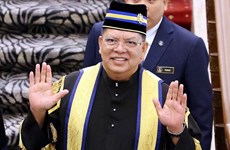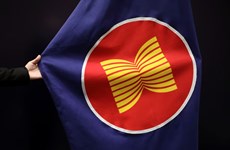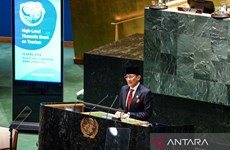French media highlight “historic trial” of lawsuit against US AO/Dioxin producers
The trial of Vietnamese-Frenchwoman Tran To Nga’s lawsuit against 14 American Agent Orange (AO)/Dioxin producers, which opened in France on January 25, has grabbed the attention of local media, which has called it “historic”.
 L'Humanité frontpages an article headlined “A story of an American war crime tried 55 years later in France”, reflecting on the lives of Nga and millions of other victims of AO/Dioxin and her enduring fight for justice over the last six years. Screenshot of L'Humanité. (Photo: VNA)
L'Humanité frontpages an article headlined “A story of an American war crime tried 55 years later in France”, reflecting on the lives of Nga and millions of other victims of AO/Dioxin and her enduring fight for justice over the last six years. Screenshot of L'Humanité. (Photo: VNA)L'Humanité frontpaged an article headlined “A story of an American war crime tried 55 years later in France”, reflecting on the lives of Nga and millions of other victims of AO/Dioxin and her enduring fight for justice over the last six years. The article said the historic trial against 14 American companies, including Dow Chemical and Bayer-Monsanto, is now entering a new phase at the Crown Court of Evry.
The lawsuit has been called a David-and-Goliath struggle, as dozens of lawyers for the multinationals have deployed all possible strategies to slow down the progress of the trial, it said, adding that a few years ago the turnover of Dow Chemical alone exceeded Vietnam’s GDP.
It also said the challenge is to have a French court recognise the association between human exposure to the ultra-toxic pesticides used by the US in the Vietnam War and the health problems experienced by Vietnamese victims. If confirmed, millions of AO/Dioxin victims could demand compensation.
Le Monde, meanwhile, emphasised that Nga knew she would have to handle a prolonged legal battle and there would be appeals and all kinds of examinations to establish whether there is a link between her health conditions and the US use of herbicides in her homeland. It said there is no other lawsuit against these agro-chemical firms who were aware of the toxicity of their products sold to US armed forces.
 Screenshot of Le Monde. (Photo: VNA)
Screenshot of Le Monde. (Photo: VNA)If Nga wins, the case would indeed recognise the responsibility of these major firms in harming human life and the environment, the newspaper added.
Liberation, meanwhile, quoted Dow Chemical’s own words as saying Agent Orange is extremely powerful with an “exceptional toxicity”. The defoliant was at the heart of the largest chemical warfare programme in the 20th century, conducted by the US not only in Vietnam but also in neighbouring Laos and Cambodia. Its lasting effects are still being felt today.
Franceinfo called Nga “an old lady” who moves slowly, but behind the fragile appearance is a grandmother who has shown all her life that she has “the soul of a fighter”. Nga lost her first daughter, it said, while the second suffers from a malformation and her grandchildren have breathing problems. For years, diseases linked to AO/Dioxin have been hidden by families in Vietnam. One of the challenges for the case is “to make visible this part of history by recognising the nature and the extent of the damage”.
 Screenshot of Reporterre. (Photo: VNA)
Screenshot of Reporterre. (Photo: VNA)It added that whatever the outcome of the trial, there will be an appeal from the chemical giants who cannot afford to lose, or from Nga who has nothing more to lose, it added.
Tran To Nga graduated from a Hanoi university in 1966 and became a war correspondent with the Liberation News Agency, now the Vietnam News Agency. She worked in some of the most heavily AO/Dioxin-affected areas in southern Vietnam, such as Cu Chi, Ben Cat, and along the Ho Chi Minh Trail, ultimately experiencing contamination herself.
From 1961-1971, US troops sprayed more than 80 million litres of herbicides - 44 million litres of which were AO, containing nearly 370 kg of dioxin - over southern Vietnam.
Around 4.8 million Vietnamese were exposed to the toxic chemicals. Many of the victims have since died, while millions of their descendants are living with deformities and diseases as a direct result of the chemical’s effects./.













